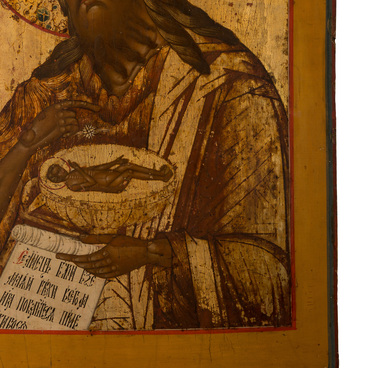The Abalak image of the Virgin is a version of the more ancient iconographic type “Our Lady of the Sign”.
The iconography of “Our Lady of the Sign” is based on the words of the prophet Isaiah about the coming of the Savior: “Therefore the Lord Himself will give you a sign: Behold, the virgin shall conceive and bear a Son, and shall call His name Immanuel” (Isaiah 7:14).
The earliest preserved image of this type on Russian soil was painted no later than the 12th century and is located in the Cathedral of St. Sophia in Veliky Novgorod. In this image, the Mother of God appears with Her hands raised in prayer. The Abalak “Our Lady of the Sign” has some differences: St. Nicholas the Wonderworker and the Venerable Mary of Egypt are depicted in its margins.
The Abalak image was painted in 1637 by Archdeacon Matfey Martynov inspired by the words of a widow Maria, who had a vision of the icon “Our Lady of the Sign” in a dream. The widow lived in the village of Abalak (near Tobolsk), hence it was so named. Soon after it was painted, the image became famous for miracles and spread throughout Russia in multiple copies. It was particularly revered in Siberia. The icon was placed in the Our Lady of the Sign Cathedral built specifically for it (1683–1691); the monastery of the same name subsequently grew around the cathedral.
One of the copies of the miraculous Abalak icon is located in Australia. In 1919, the retreating White Army moved it from Abalak to Omsk, and then the copy, along with the emigrants, was abroad and is now in Australia, in the Protection of the Holy Virgin Church of Cabramatta, in a suburb of Sydney. Descendants of General Mikhail Konstantinovich Diterikhs handed the icon over to this church.
The presented image is one of the numerous copies
of the Abalak icon. The background and margins are decorated using the
techniques of engraving and embossing on gesso (levkas). The embossed
background is covered with tin-based paint, over which drying oil is applied.
The combination of these cheap materials that imitate gold gives the icon an
expensive look. The ornaments on the fields are painted in different colors.
The faces, hands and robes are painted using both Old Russian and modern
pictorial techniques. The icon was once subjected to commercial restoration;
the added layers differ in places.


